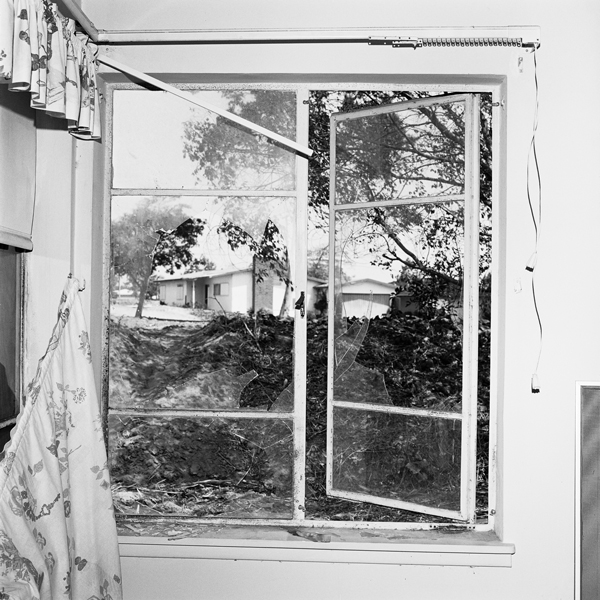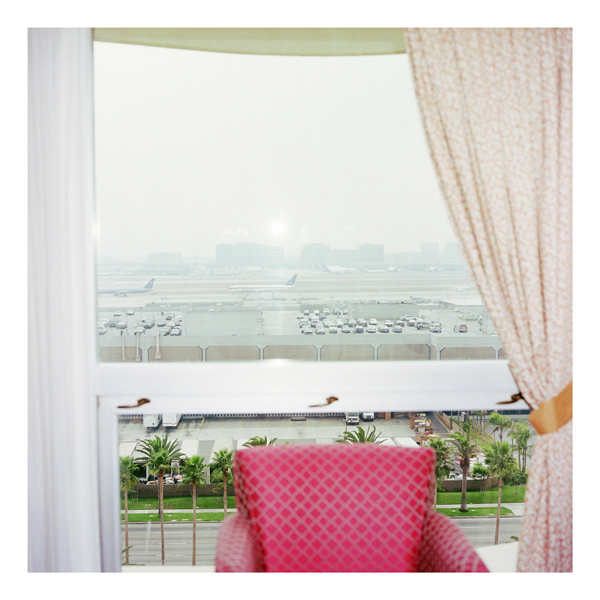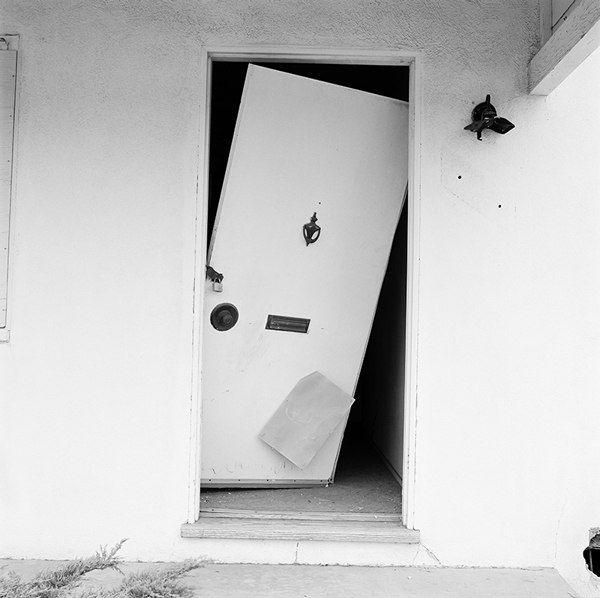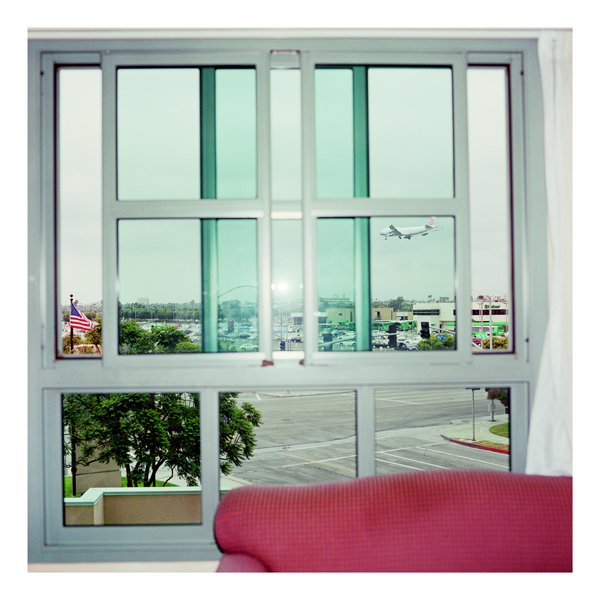John Divola is fascinated with the ruins we leave behind. He’s a trespasser by trade, wandering into suburban homes that have been abandoned or condemned, using his camera to document forgotten living rooms that have been stripped of human comforts and left to random acts of vandalism. He returns often to these domestic discomfort zones, even adding his own spray-painted graffiti of abstract shapes to the walls around him.
One of his earliest projects was “LAX NAZ,” which took him to a ghost-town neighborhood close to Los Angeles International Airport, where the middle-class American dream home once stood as proudly as anywhere else in Southern California. By the time Divola arrived in 1975, the houses were empty and surrendered to impending airport expansion. In house after house, the photographer found shattered windows and doors off their hinges, stained carpet and punctured dry wall. In a playful self-portrait from the series, Divola is reflected in a cracked bedroom mirror in sneakers and ponytail, Hasselblad in one hand, strobe in the other—a picture of the artist as a young home invader.

John Divola, LAX NAZ, Site 25 int B-1, 1975.
The photographs are part of “Experience 35: GROUNDED” now at ESMoA in El Segundo through September 22. The exhibition pairs his stark black-and-white images with a more recent series of color pictures by Zoe Crosher called “Out the Window (LAX),” shot in hotel and motel rooms in the flight path of the same busy airport. In both cases, the photographers are there as visiting voyeurs just passing through.
Crosher was born the same year that Divola invaded his LAX abodes four decades ago, and her work here is layered with meanings both wistful and potentially ominous. Curated by Colin Westerbeck, the show collides Divola’s seemingly dry, objective approach against Crosher’s chromatic images, which gaze longingly out hotel windows to passenger jets coming in for a landing.

Zoe Crosher, ZC LAX Marriott, 2003.
The location of ESMoA, itself near LAX, was the source of inspiration for Westerbeck, an author, critic and former director of the California Museum of Photography in Riverside. At the far end of the gallery is a large map with white dots that estimate the locations of Divola’s doomed houses around the airport, while other dots identify the rented rooms of Crosher and of the museum itself.
The LAX pictures were Divola’s first major project after earning his MFA in 1974 at UCLA, where he’d studied with Robert Heinecken. He grew up in the San Fernando Valley bedroom community of Reseda and attended nearby Cal State Northridge before grad school. For more than 40 years, Divola has devoted himself to examining natural and unnatural environments, from the arid desert to the carefully attended suburban neighborhoods remembered from his youth.
Divola’s “Zuma” series from 1979 documented the destruction of an abandoned house overlooking the ocean that was used for firefighter training, and each image captured a different stage of decay in vivid color against a background of blue skies and sunsets. His mid-nineties series “Isolated Houses” finds small dwellings amid the brush and grit of the SoCal desert.
The photographs shot outside LAX were a moment of discovery, furthering an invasive aesthetic that would follow him throughout his career. The pictures reveal what he found inside the homes: evidence of repeated break-ins, with screens and curtains torn away, discarded newspapers and sliding glass doors with safety glass shattered into shiny pebbles. Outside, the trimmed lawns and succulents are a startling contrast to the boarded windows and chaos within.
The transformation of these family homes is made complete within “GROUNDED” by including another series of color images created by Divola a year later: diptychs that present a house in one image beside another of the same property with the structure brutally cleared away.
Crosher was born in Northern California, but as the daughter of a diplomat father and a mother who was a stewardess, she grew up partly overseas. Travel is a comfortable concept. Her pictures at “GROUNDED” suggest small dramas and dreams of escape with hotel room interiors that might include a discarded piece of clothing, fast food detritus or a rumpled blanket. These foregrounds are purposely out of focus and anonymous, signifying a temporary place to crash or to hide, not a real home.
In the distance are the passenger jets, arriving at LAX and a city equally known for its wild fantasies and its noir nightmares. It’s a range of possibility Crosher explored in “The Michelle duBois Project,” her re-contextualizing of a found cache of private, sexually charged photographs of a woman who appears to be a stewardess traveling the world and exploring different identities. But her “Out the Window (LAX)” pictures deliver a different kind of Kodak moment, with no people to see, only a strong desire to fly or to flee.

John Divola, LAX site 26 ext A, 1975;
Proximity to LAX is the common thread between Divola and Crosher’s bodies of work here, and Westerbeck insists, “They couldn’t be more different in their approach to this subject.” But a sense of melancholy can be found in both. Divola shows the family home not as a safe pillar of the American dream, but as something utterly expendable. And in Crosher’s photographs, it is the individual who is easily discarded, as the hotel rooms remain to host another guest on the run, and arriving planes deliver endless waves of visitors to be welcomed or devoured.


